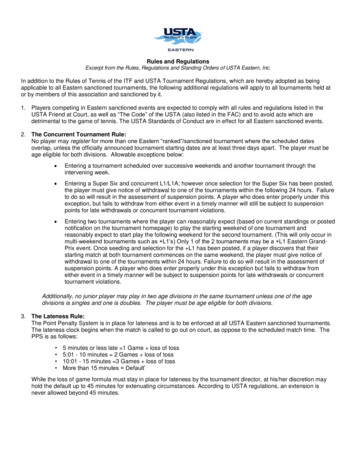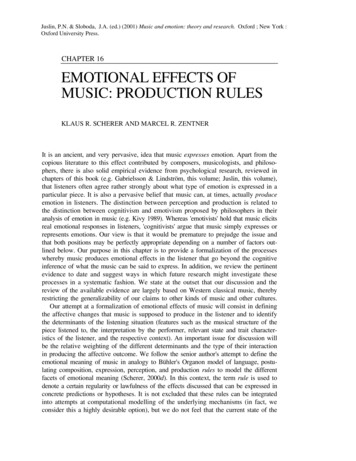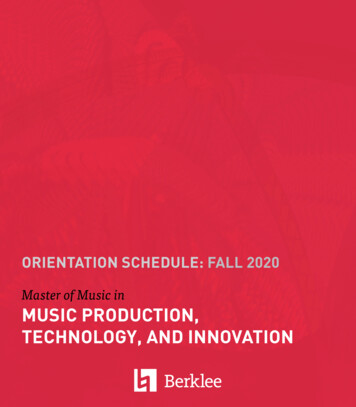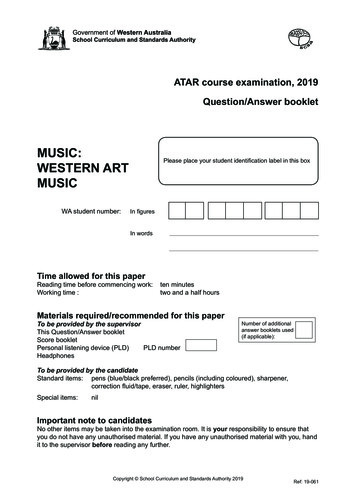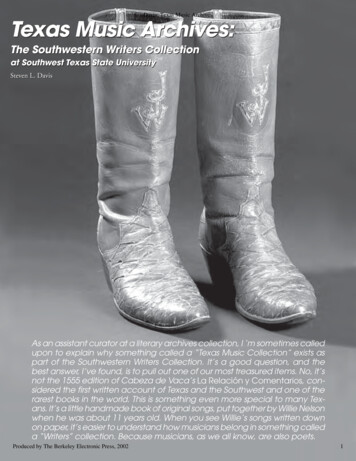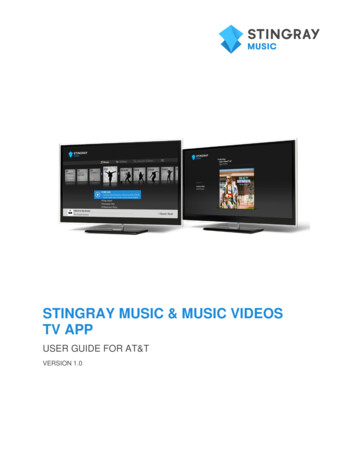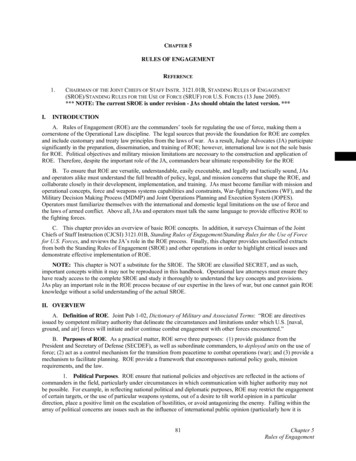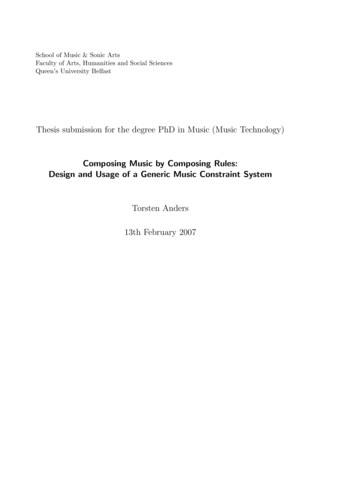
Transcription
School of Music & Sonic ArtsFaculty of Arts, Humanities and Social SciencesQueen’s University BelfastThesis submission for the degree PhD in Music (Music Technology)Composing Music by Composing Rules:Design and Usage of a Generic Music Constraint SystemTorsten Anders13th February 2007
AbstractThis research presents the design, usage, and evaluation of a highly generic music constraint system called Strasheela. Strasheela simplifies the definition of musical constraintsatisfaction problems (CSP) by predefining building blocks required for such problems.At the same time, Strasheela preserves a high degree of generality and is reasonablyefficient.Strasheela is highly generic, because it is highly programmable. In particular, threefundamental components are more programmable in Strasheela compared with existingmusic constraint systems: the music representation, the rule application mechanism, andthe search process.Strasheela features an expressive symbolic music representation. This representation supports explicitly storing score information by sets of score objects, their attributes, andtheir hierarchic nesting. Any information available in the score is accessible from anyobject in the score and can be used to obtain derived information. The representationis complemented by the notion of variables: score information can be unknown and suchinformation can be constrained.This research proposes a rule formalism which combines convenience and full user control to express which score variable sets are constrained by a given rule. A rule is afirst-class function. A rule application mechanism is a higher-order function. A rule application mechanism traverses the score in order to apply a given rule to variable sets.This text presents rule application mechanisms suitable for a large set of musical CSPsand reproduces important mechanisms of existing systems.Strasheela is founded on a constraint programming model which makes the search processprogrammable at a high-level. The Strasheela user can optimise the search for a particular constraint satisfaction problem by programming a distribution strategy (a dynamicvariable and value ordering) independent of the problem definition. Special distributionstrategies for efficiently solving various musical CSPs – including complex polyphonicproblems – are presented.iii
iv
AcknowledgementsFirst and foremost I want to thank my supervisors, Michael Alcorn and Christina Anagnostopoulou, for their guidance and support throughout this research study. I am gratefulto Michael for giving me the opportunity to work at the Sonic Arts Research Centre.It was a privilege and fun to work in a place with such a stimulating atmosphere. I amindebted to Christina who helped me to clarify the views presented in this thesis.I am grateful to many people with whom I have discussed by PhD work: Stefan Bilbao,Ludger Brümmer, Darrel Conklin, Mikael Laurson, Camilo Rueda, Örjan Sandred andAlan Smaill. I have greatly benefited from their experience and constructive criticism.Kilian Sprotte was the first who dared to actually use Strasheela.I would like to thank the Oz community. Denys Duchier answered countless questions Ihad when I began with this research. Christian Schulte and Raphael Collet helped meto better understand Oz’ constraint programming model. Many more members of theOz mailing list were always willing to help.I was very happy being surrounded by so many friendly and helpful fellow PhD students: Tom Davis, David Fee, Jason Geistweidt, Katarzyna Glowicka, Banu Günel, HussHacıhabiboğlu, Rachel Holstead, Ravi Kuber, Christopher McClelland, Erdem Motuk,Emma Murphy, Damian Ryan, Philip Strain, Evren Tekin, and Henry Vega. I thank theQueen’s University for funding my PhD research.For detailed feedback on drafts of this work I am grateful to Christina Anagnostopoulou,Eoin Brazil, Cornelius Pöpel, and Chris Share. Chris Share also answered many questionsI had on English language usage.Finally, I would like to thank my wife Mechthild for all her support throughout theseyears.v
vi
Contents1. Introduction1.1. Computer-Aided Composition . . . . . . . . . . . . . .1.2. Constraint-Based Computer-Aided Composition . . .1.3. Requirements for a Generic Music Constraint System .1.4. The Approach Taken . . . . . . . . . . . . . . . . . . .1.5. Outline . . . . . . . . . . . . . . . . . . . . . . . . . .1124682. Survey I: Issues in Music Representation for Computer-Aided Composition2.1. Introduction . . . . . . . . . . . . . . . . . . . . . . . . . . . . . . . . . .2.1.1. What is a Music Representation? . . . . . . . . . . . . . . . . . .2.1.2. The Broader Perspective . . . . . . . . . . . . . . . . . . . . . . .2.1.3. Terminology . . . . . . . . . . . . . . . . . . . . . . . . . . . . .2.2. A Basic Representation: Event List . . . . . . . . . . . . . . . . . . . . .2.3. Parameter Representation . . . . . . . . . . . . . . . . . . . . . . . . . .2.4. Topologies of Hierarchic Representations . . . . . . . . . . . . . . . . . .2.4.1. Two-Dimensional Representation . . . . . . . . . . . . . . . . . .2.4.2. Representation with Specialised Containers in a Tree . . . . . . .2.4.3. Representation with Generic Containers in a Tree . . . . . . . .2.4.4. Representation with Containers in an Acyclic Graph . . . . . . .2.4.5. Summary . . . . . . . . . . . . . . . . . . . . . . . . . . . . . . .2.5. Extensibility . . . . . . . . . . . . . . . . . . . . . . . . . . . . . . . . .2.6. Textual Representation vs. Data Abstraction . . . . . . . . . . . . . . .2.7. Class Hierarchy . . . . . . . . . . . . . . . . . . . . . . . . . . . . . . . .2.8. Higher-Order Programming for Score Processing . . . . . . . . . . . . .2.9. Conclusion . . . . . . . . . . . . . . . . . . . . . . . . . . . . . . . . . 464758613. Survey II: Composing with Constraint Programming3.1. What is Constraint Programming? . . . . . . . .3.2. Constraint-Based Composition . . . . . . . . . .3.2.1. Motivation . . . . . . . . . . . . . . . . .3.2.2. A First Example . . . . . . . . . . . . . .3.2.3. Musical Constraint Satisfaction Problems3.3. Generic Music Constraint Systems . . . . . . . .3.3.1. PWConstraints . . . . . . . . . . . . . . .3.3.2. Situation . . . . . . . . . . . . . . . . . .3.3.3. OMClouds . . . . . . . . . . . . . . . . .vii
Contents3.3.4. Other Systems . . . . . . . . . . . . . . . . . . . . . . . . . . . . . 633.4. Conclusion . . . . . . . . . . . . . . . . . . . . . . . . . . . . . . . . . . . 644. Motivation and System Overview4.1. Limited Generality of Existing Systems4.1.1. Music Representation . . . . . .4.1.2. Rule Formalism . . . . . . . . . .4.1.3. Search Strategy . . . . . . . . . .4.2. The Research Goal . . . . . . . . . . . .4.3. Strasheela Design Overview . . . . . . .4.3.1. Search Strategy . . . . . . . . . .4.3.2. Rule Formalism . . . . . . . . . .4.3.3. Music Representation . . . . . .65656668717273737576Strasheela Music RepresentationOverview: Score Object Classes . . . . . . . . . . . . . . . . . . . .Class Hierarchy . . . . . . . . . . . . . . . . . . . . . . . . . . . . .Textual Representation and Data Abstraction . . . . . . . . . . . .Hierarchic Representation . . . . . . . . . . . . . . . . . . . . . . .5.4.1. The Parameter Class: Variables in the Representation . . .5.4.2. The Event Class . . . . . . . . . . . . . . . . . . . . . . . .5.4.3. The Container Class . . . . . . . . . . . . . . . . . . . . . .5.4.4. Temporal Hierarchy . . . . . . . . . . . . . . . . . . . . . .5.5. The Data Abstraction Interface . . . . . . . . . . . . . . . . . . . .5.5.1. Basic Interface . . . . . . . . . . . . . . . . . . . . . . . . .5.5.2. Generic Interface for Hierarchic Structures . . . . . . . . . .5.6. Score Contexts . . . . . . . . . . . . . . . . . . . . . . . . . . . . .5.6.1. Principles for Expressing Score Information . . . . . . . . .5.6.2. User-Defined Score Contexts . . . . . . . . . . . . . . . . .5.6.3. The Generality of the Strasheela Score Context 112113114114115115116117118120121122.5. The5.1.5.2.5.3.5.4.6. The Strasheela Rule Formalism6.1. Constraints and Rules are First-Class Functions . . . . . . . . . .6.2. Programmable Rule Application . . . . . . . . . . . . . . . . . .6.2.1. Direct Rule Application to a Single Object . . . . . . . .6.2.2. Applying a Rule to Every Element in a List . . . . . . . .6.2.3. Applying a Rule to Neighbours in a List . . . . . . . . . .6.2.4. User-Defined Rule Application Mechanisms . . . . . . . .6.2.5. Index-Based Rule Application . . . . . . . . . . . . . . . .6.2.6. Rule Application with a Pattern Matching Language . . .6.2.7. Rule Application to Selected Objects in a Score Hierarchy6.2.8. Implicit Rule Application . . . . . . . . . . . . . . . . . .6.2.9. Rule Application to Arbitrary Score Contexts . . . . . . .6.3. Constraining Inaccessible Score Contexts . . . . . . . . . . . . . .viii.
Contents6.3.1.6.3.2.6.3.3.6.3.4.6.3.5.The Inaccessible Score Context ProblemDelayed Rule Application . . . . . . . .Reformulating the Problem Definition .Using Logical Connectives . . . . . . . .Comparison . . . . . . . . . . . . . . . .7. How Strasheela Finds a Solution7.1. The Underlying Programming Model . . . . . . . . . . .7.2. The Constraint Model Based on Computational Spaces7.2.1. Propagate and Search . . . . . . . . . . . . . . .7.2.2. An Example . . . . . . . . . . . . . . . . . . . .7.2.3. Features of the Space-Based Constraint Model .7.3. Specialising the Constraint Model for Music . . . . . . .7.3.1. The Basic Idea . . . . . . . . . . . . . . . . . . .7.3.2. Score Distribution Strategies . . . . . . . . . . .8. Strasheela Examples8.1. Fuxian First Species Counterpoint . . . . . . . . .8.1.1. The Music Theory . . . . . . . . . . . . . .8.1.2. The Formal Model . . . . . . . . . . . . . .8.1.3. Search Process and Results . . . . . . . . .8.1.4. Conclusion . . . . . . . . . . . . . . . . . .8.2. Florid Counterpoint . . . . . . . . . . . . . . . . .8.2.1. The Music Theory . . . . . . . . . . . . . .8.2.2. Search Process and Results . . . . . . . . .8.3. Constraining the Shape of the Temporal Hierarchy8.3.1. Motivation . . . . . . . . . . . . . . . . . .8.3.2. Approach . . . . . . . . . . . . . . . . . . .8.3.3. Elimination of Symmetries . . . . . . . . .8.3.4. Discussion . . . . . . . . . . . . . . . . . . .9. The Strasheela Prototype9.1. Relation to the Model Presented . . . . . . . . . . . . .9.1.1. Input and Output . . . . . . . . . . . . . . . . .9.1.2. Extended Strasheela Core Music Representation9.1.3. Extensions for Specific CSP Classes . . . . . . .9.2. Programming Language Issues . . . . . . . . . . . . . .9.3. Limitations of the Prototype . . . . . . . . . . . . . . .10.Comparison and Evaluation10.1. Music Representation . . . . .10.1.1. Representation Format .10.1.2. Constrainable Aspects .10.2. Rule Formalism . . . . . . . . .122123124125126.129. 129. 130. 131. 134. 135. 144. 144. 147.155. 156. 156. 157. 163. 165. 168. 168. 169. 171. 171. 172. 172. 174.177. 177. 177. 178. 178. 182. 183.187. 188. 189. 194. 197ix
Contents10.3. Search Strategy . . . . . . . . . . . . . . . . . . . . . . . . . . . . . . . . . 19910.4. Can Strasheela be Further Generalised? . . . . . . . . . . . . . . . . . . . 20010.5. Summary . . . . . . . . . . . . . . . . . . . . . . . . . . . . . . . . . . . . 20111.Conclusion20311.1. Main Contributions . . . . . . . . . . . . . . . . . . . . . . . . . . . . . . . 20311.2. Future Work . . . . . . . . . . . . . . . . . . . . . . . . . . . . . . . . . . 204A. Notational ConventionsA.1. Variables . . . . . . . . . .A.2. Functional Abstraction . . .A.3. Control Structures . . . . .A.4. Values and Data StructuresA.5. Operations . . . . . . . . .209209210210211211B. Additional Definitions213C. The Strasheela Website217D. Source Material219x
1. Introduction1.1. Computer-Aided CompositionComputers nowadays play an important role in many areas of music composition andits production. In particular, sound synthesis and effects processing plays an importantrole. By contrast, computer-aided composition utilises the computer in order to createsymbolic scores. It focuses on higher-level musical concepts such as notes, chords, motifs,or the musical texture.In the field of computer-aided composition (CAC, also known as algorithmic composition1 ) composers formalise their musical intentions and implement these formal specifications as computer programs. These programs output music which the composer thenuses in the composition process. For writing such programs, composers use either generalpurpose programming languages or special composition systems with programming support. Particularly widely-used composition systems include PatchWork [Laurson andDuthen, 1989; Laurson, 1996], the two PatchWork successors OpenMusic [Assaya
ports explicitly storing score information by sets of score objects, their attributes, and their hierarchic nesting. Any information available in the score is accessible from any object in the score and can be used to obtain derived information. The representation is complemented by the notion of variables: score information can be unknown and such information can be constrained. This research .

